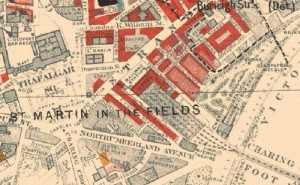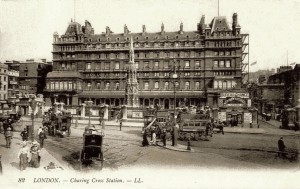The original station was built on the site of the Hungerford Market by the South Eastern Railway. Opened on January 11th 1864. The station was designed by Sir John Hawkshaw, with a single span wrought iron roof arching over the six platforms. A large portion of roof collapsed on 5 December 1905 compromising part of the west wall. A bunch of men were employed in repairing, glazing and painting the section of roof which fell. The roof, girders and debris fell across four passenger trains standing in platforms 3, 4, 5 and 6 and all rail lines were blocked. The part of the western wall which fell crashed through the wall and roof of the neighboring Royal Avenue Theater in Northumberland Avenue which was being reconstructed at the time. Six lives were lost.
The Charing Cross Hotel, designed by Edward Middleton Barry, opened on 15 May 1865 and gave the station a frontage of the French Renaissance style.Following bomb damage in the Second World War, the hotel received extensive repairs in 1951. In general, this consisted of a new set of top floors.

Charing Cross Station is at home in a middle class district.
“Charing” comes from the Old English word cierran meaning to turn. This is a fitting place for the turning point in a story. This is also why Amy Levy used this station in her novel.

In Romance Of A Shop by Amy Levy Charing Cross Station is a turning point for phyllis’s health. As she plans to run away to go get married to Darrell she becomes sicker and can’t manage the journey. Charing cross station, although only briefly mentioned represents a larger picture of health and a turning point in the story. It’s after this point that we find out just how sick Phyllis is. It’s also at this station that Phyllis herself turns around and returns to Darrell’s house.
Work Cited
“Booth Poverty Map (Charles Booth Online Archive).” Booth Poverty Map (Charles Booth Online Archive). Web. 3 Dec. 2015.
Levy, Amy.The Romance of a Shop. Peterborough, Ont.: Broadview, 2006. Print.
“The Charing Cross Hotel by E. M. Barry (1830-80).” The Charing Cross Hotel by E. M. Barry (1830-80). Web. 7 Dec. 2015.
“Victorian London.” Google Books. Web. 3 Dec. 2015.
“Victorian London – Transport – Railways, Above Ground – Stations – Charing Cross.” Victorian London – Transport – Railways, Above Ground – Stations – Charing Cross. Web. 3 Dec. 2015.

